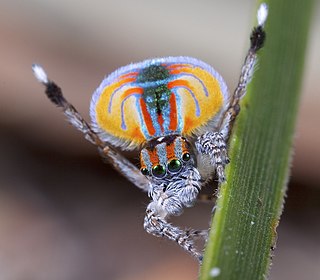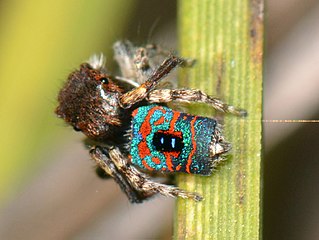
Maratus is a spider genus of the family Salticidae. These spiders are commonly referred to as peacock spiders due to the males' colorful and usually iridescent patterns on the upper surface of the abdomen often enhanced with lateral flaps or bristles, which they display during courtship. Females lack these bright colors, being cryptic in appearance. In at least one species, Maratus vespertilio, the expansion of the flaps also occurs during ritualised contests between males. The male display and courtship dance are complex, involving visual and vibratory signals.

Peckhamia is a peer-reviewed, open-access, scientific journal covering research on jumping spiders. It is published by the Peckham Society, an international organization of naturalists and scientists with an interest in jumping spiders, named in honor of George and Elizabeth Peckham. The journal was established in 1977 and its current editor-in-chief is David E. Hill.

Maratus speciosus, sometimes called the coastal peacock spider, is an Australian species of jumping spider. They are only known to inhabit the vegetation of the coastal sand dunes of southwestern Western Australia. Like other Maratus spiders, the males of the species engage in a courtship display during which they raise their third pair of legs and their abdomen, presenting their colorful opisthosomal plate to potential female partners. Unlike other Maratus, however, the males of this species have a set of bright orange hairs (setae) along both edges of the opisthosoma which only become visible during this display.
Maratus jactatus is a species of the genus Maratus, an Australian member of the jumping spider family. Maratus Jactatus have the ability to jump lengths up to 50 times their size of about 10mm. The female has a cryptically colored back, whereas the male has the colorful back. They have been collected only in Wondul Range National Park in southern Queensland. Like other Maratus spiders, the males of the species engage in a courtship display, during which they extend their median and posterior fringed spinnerets. They also spread the flaps from over their inflated opisthomal plate, revealing unique iridescent blue scales "interrupted by three bold transverse bands of red-orange to orange pigmented scales." A male presents both the extended spinnets and his expanded and inflated opisthoma as he faces the female that he courts. However, depending on the colors of the male, the female may be more likely to go to another male or not be attracted to certain males.
Maratus sceletus is a species of the genus Maratus, an Australian member of the jumping spider family. Described in 2015, they have been collected only in Wondul Range National Park in southern Queensland. The species name is derived from the Latin sceletus "skeleton", from its distinctive body pattern. Maratus sceletus is a small species, from 3.7 to 4.7 mm long. The male is black with prominent white stripes and markings across its carapace and legs.

Maratus nigromaculatus is a species of the genus Maratus, an Australian member of the jumping spider family. Described in 1883 by Keyserling as Ergane nigromaculata from a specimen from Rockhampton, they are found in Queensland. The species name is derived from the Latin words niger "black" and maculatus "spotted".

Maratus vespertilio is a species of the genus Maratus, an Australian member of the jumping spider family. Males expand their colorful abdominal flaps for display during courtship as well as in contests with other males.

Maratus spicatus is a species of the genus Maratus, an Australian member of the jumping spider family. It was described in 2012 and is native to Western Australia.
Maratus albus is a species of the peacock spider genus, characterised by its distinctive courtship display.
Maratus australis is a species of the peacock spider genus, characterised by its distinctive courtship display.
Maratus bubo is a species of the peacock spider genus, characterised by its distinctive courtship display.
Maratus lobatus is a species of the peacock spider genus, characterised by its distinctive courtship display.
Maratus tessellatus is a species of the peacock spider genus, characterised by its distinctive courtship display.
Maratus vespa is a species of the peacock spider genus, Maratus, characterised by its distinctive courtship display. The male spiders are characterized by a bright abdomen, lateral flaps, and an elongated third pair of legs. When attempting to attract a mate, the male spider will raise its colorful abdomen and elongated third pair of legs and wave them, along with extending its lateral flaps. This complex display of courtship is analogous of that of a peacock, hence the common name of this spider species.
Maratus vultus is a species of the peacock spider genus, characterised by its distinctive courtship display.
Maratus harrisi is a species of the genus Maratus, an Australian member of the jumping spider family. It was described in 2011 and is native to the Australian Capital Territory.
Saratus is a genus of Australian jumping spiders containing the single species, Saratus hesperus. It was first described by J. C. Otto & D. E. Hill in 2017, and has only been found in Australia. It is placed in the tribe Euophryini of the subfamily Salticinae.
Maratus combustus is a species of peacock spider native to Australia. The species was discovered together with Maratus felinus and Maratus aquilus by a research group from Monash University, near Lake Jasper in the South West region of Western Australia. However, the ranges of each species do not overlap.

Maratus pavonis is a species of jumping spider (Salticidae), endemic to Australia, where it is found in Western Australia, New South Wales, Victoria and Tasmania. The species epithet, pavonis, derives from the Latin, pavo, pavonis, meaning "peacock".

Maratus mungaich, the banksia peacock spider, is a species of jumping spider in the family Salticidae. It is endemic to Western Australia.







